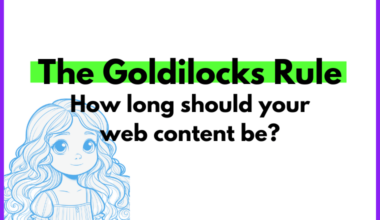On many SERPs, an interactive People Also Ask box appears near the top of the first page. Google compiles these related questions and answers to meet related queries to the given keyword.
There are several ways to improve your chances of ranking in those People Also Ask boxes on a Google SERP. Our favorite secret is NLP, but there are other strategies we’ll share below.
Ultimately, ranking for the People Also Ask search feature should not be your number one priority, but can improve your overall content and even inspire otherwise elusive content ideas.
We may earn a small commission from purchases made via links on this page. It doesn’t cost you anything extra, but it allows us to keep creating great content.
What is the “People Also Ask” box on Google?
The People Also Ask (PAA) section on Google Search is a clickable question that many people may want to be answered if they input a particular search query. Once you click on it, the answer drops down. Google compiles these answers from third-party sites.
For instance, for the search engine query “gutenberg,” the PAA box appears after the first two search results on desktop.

On mobile, the PAA box appeared after only the first search result for the same query, and it can include different questions.
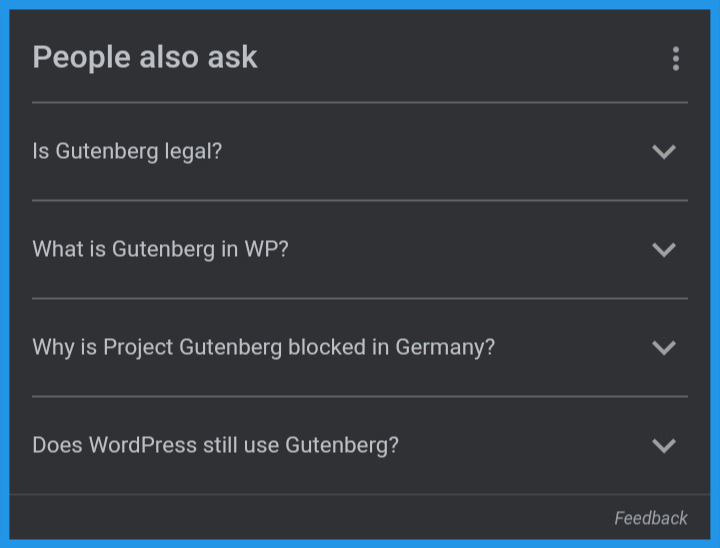
When you click on a question, the answer drops down. Important terms are bolded. When you click one question, more questions appear below.
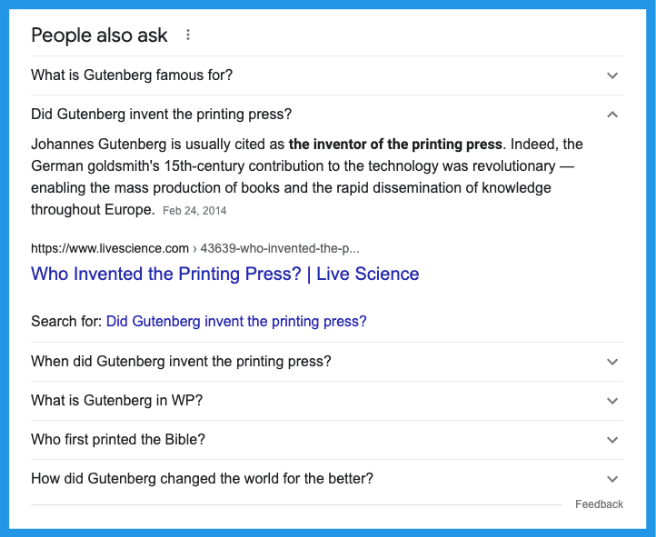
3 out of 4 times that a PAA result appears, its placement sits in the top 3 results in the SERP.
How do you open People Also Ask? You open a PAA box by clicking anywhere on the question, not just on the little arrow on the right.
Although ranking for a PAA box increases your organic impressions and often increases your organic clicks, Google doesn’t really want users to click on your post.
Over time, Google has significantly decreased clicks from search results by adding more on-SERP features, from knowledge graphs to featured snippets to tools and more.
Many sources claim this is partly due to voice search exploding in popularity. But while that’s not entirely false, the statistics used to drive home this point aren’t totally legit.
Now, back to PAA.
Where does the PAA box show up on the SERP?
The PAA box shows up in many different places on the SERP. Often, it will place second or third, but Google sticks it wherever Google thinks users will need it. A PAA box may be result #1 or #10, although it’s typically found above the final 2 search positions.
PAA boxes seem to appear slightly higher on mobile search results than on desktop.
Examples of where PAA boxes appear:
- For “sherlock holmes new movie,” the PAA box appears right after the featured snippet box on desktop and mobile. This is common for popular search queries.
- For “ibs diet,” the PAA box appears after 4 ads and the first organic result on desktop and mobile.
- For “how to write a comic book about secret agents”, the PAA box appears after two ads and 3 organic search results on desktop. On mobile, there were 3 ads, pushing the PAA box down to #7.
- For “xbox series x,” no PAA box appears on desktop results. On mobile, a PAA box appears after the Shop carousel, the first result, then the Top Stories carousel.
How many search results include People Also Ask questions?
According to various sources, PAA boxes appear in at least 40% of all search results pages. This has continued to increase since Google introduced PAAs in 2015. (Doesn’t it feel like PAAs have been around a lot longer?)
Almost all high-volume search queries feature PAAs.
Search queries beginning with question words (who, what, when, why, how, which) are almost doubly likely to feature a PAA box than a non-question word-containing search query.
There are slightly more PAAs on mobile than on desktop. PAAs may appear slightly higher on mobile than on desktop. Mobile PAAs may even list different questions because mobile users have different questions than desktop users, depending on the query.
How many PAAs appear for a single search result?
One PAA box containing 4 questions almost always appears for a single search result. If you click on any of these specific questions, 1-3 more questions may appear below. The number of questions that can populate seems to be infinite if you keep clicking other questions.
If you continue to click on the questions, more questions may appear until the PAA box grows to absurd lengths.
A PAA box for an obscure or long-tail search query may feature fewer questions than 4, but 4 questions within a PAA is standard.
PAA Answer Formats
The ideal PAA answer format…
- …is easy to read.
- …directly answers the question.
- …is short — preferably fewer than 50 words.
- …does not require the context of the rest of the article to understand the answer.
Most PAA answers are text-only. However, you may need to format your answer in a table, ordered list, unordered list, image, or video for specific questions.
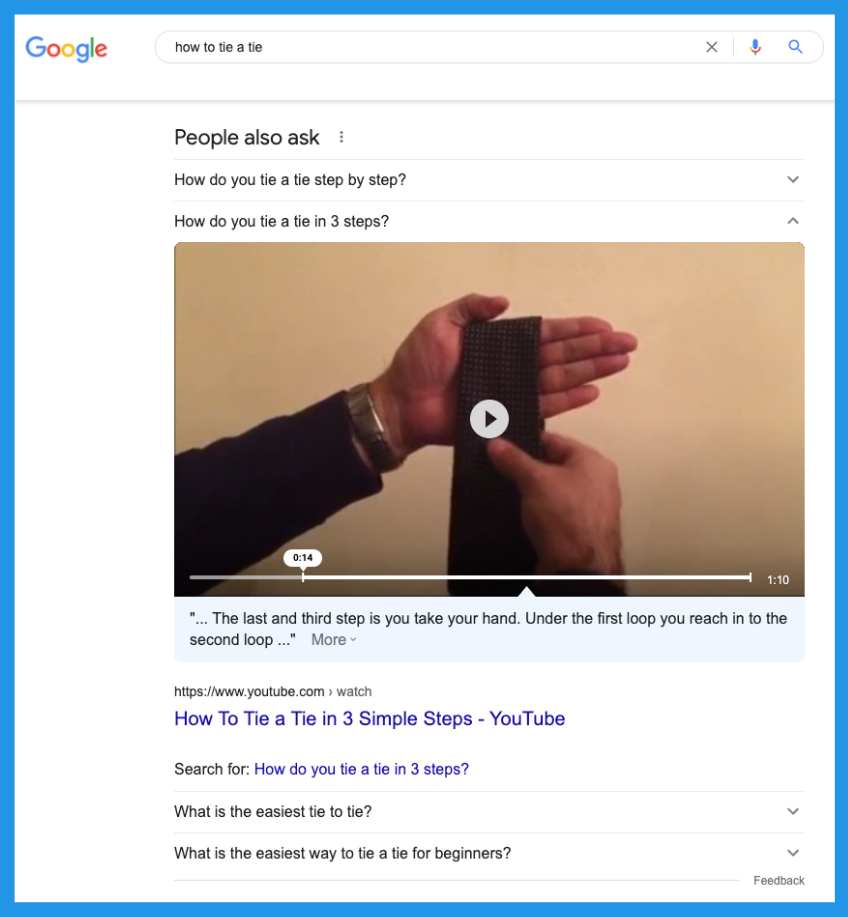
If you want to rank for a PAA question, you need to write the answer within your web page concisely, simply, and directly.
Write out the question, then answer it by restating the question as verbatim as possible. Stating and restating the question may feel robotic, but it’s easier for Google bots to read and easier for readers to understand without the context of the rest of the article.
(They are robots, after all.)
If you’re answering a frequently asked question with a list, keep that list between 4 and 8 list items if possible. This falls within the average length of PAA lists and tables. Anything beyond 8 list items will probably never appear in a PAA box. Tables may display up to 14 rows.
Imagine the answer to the PAA question is the only paragraph someone might read from your post. Does it still make sense? It needs to.
Do PAA questions always have the same answer?
Yes, PAA questions always have the same answer. PAA questions may appear across multiple search terms, but Google seems to use the same source and answer snippet every time.
This seems likely to change as Google finds new ways to meet user-specific search intent across multiple queries. But, for now, it appears that Google always attaches the same source and passage to each PAA question.
People Also Ask and SEO: Does ranking for questions matter?
Ranking for People Also Ask questions certainly increases your organic impressions, but it can also boost your organic clicks. So yes, ranking for PAA questions does matter in SEO terms.
A post featured as a PAA answer may be the quality Google wants for a higher-ranking article in general. Remember: Unlike Featured Snippets, your page can rank for a PAA question and a standard blue link on the same SERP.
A majority of sites featured in the PAA box do not appear in the SERP for that query. PAA boxes can be an excellent opportunity for lower-authority sites to rank high and build organic traffic.
There’s no solid data on how ranking in a PAA box affects organic traffic, so I’m using personal experience and common sense here. Whenever a low-ranking site is featured in a PAA box, its visibility goes up, which can really only be a good thing.
How to Optimize Content for People Also Ask Boxes
How do you answer People Also Ask questions in SEO writing? Here are 6 ways to optimize your SEO writing for answering PAA questions:
- Use Natural Language Processing.
- Keep answers short.
- Answer in the format that Google expects.
- Use schema markup.
- Focus on answering the right kind of questions.
- Improve your overall content.
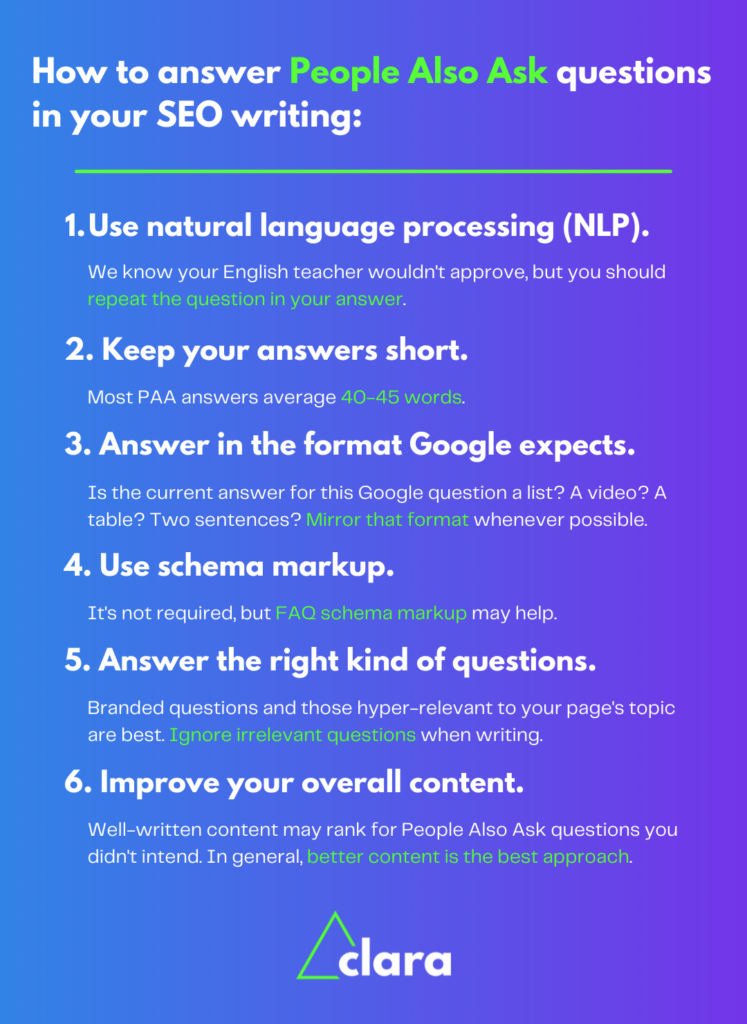
1. Use Natural Language Processing.
Natural Language Processing (NLP) refers to how computers and artificial intelligence can “read” spoken and written languages.
Writing for NLP is a simple, direct way of writing that may annoy your high school English teacher, but is easier for both Google bots and Google users to understand.
It’s tempting to write in a bloggy, trendy, conversational tone. However, very straightforward language can go a long way when you’re trying to rank your blog posts.
- Written in a conversational tone: If you really want to put pen to paper and produce the baby — I mean, story — that’s been living inside you for a long time, you absolutely must have a great hook to reel in potential readers.
- Written in NLP: If you want to write a book, you need a hook. A hook is an interesting concept that should intrigue readers to read your story.
Check out this real-life screenshot of how straightforward the language should be:

This is also important for meeting your end-user where they are — and for many readers, “where they are” might be “learning to speak conversational English.”
Keeping PAA answers short and to the point helps young searchers or those learning your language understand the point, even if it’s not stated as playfully.
When we write blog posts for clients, we literally ask the question then immediately restate the question in the answer. It sounds repetitive and robotic, but this makes it simpler for people to comprehend out of context.
Say, if that one paragraph was all the reader saw…
2. Keep answers short.
Most PAA answers are in paragraph form — 48% are text only. In that case, keep your answer length short.
The average answer length seems to be 40-45 words. Answer questions immediately and concisely, and you’re more likely to rank in the PAA box.
3. Answer in the format that Google expects.
Although most PAA answer boxes are text-only, Google expects many answers to contain lists — ordered and unordered. Sometimes, a picture or table may best answer a question.
When trying to rank for PAA questions, check the format of the current answer. It’s wise to mimic that format. (Obviously, don’t plagiarize the content; use it to inspire your own.)
4. Use schema markup.
Whatever format you use, feel free to use Q&A or FAQ schema markup to boost your chances of ranking for PAA.
Although schema markup isn’t required, it seems to help.
5. Focus on answering the right kind of questions.
You’ll undoubtedly find irrelevant questions that aren’t worth covering in your blog post.
You may also find competitor answers that you want to snatch away. Branded content questions often have a low search volume, but you can’t have your competitors answering questions in a way that messes with your conversions.
Check out this PAA question about TurboTax that TurboTax should optimize for, so they control the conversation around their product:
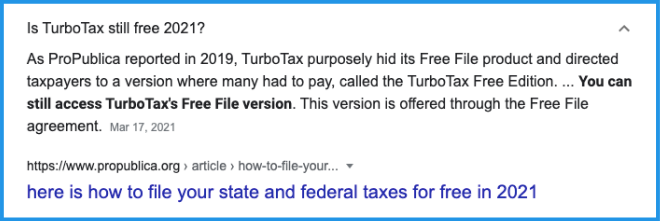
Make sure not to optimize for a PAA question for which your existing content is already the answer. If you’re already ranking for a PAA question on one page, don’t answer it on another page. No need to waste time cannibalizing your own content!
6. Improve your overall content.
2 important notes about improving overall content creation:
- Writing better overall content will improve your chances of ranking for PAA boxes.
- Optimizing for PAA boxes should improve your overall content as a happy side effect.
Optimized, high-quality content is more likely to rank in PAA results because Google sees that it is good content.
Incorporating PAA questions will improve your content outlines and content quality by better matching search intent — what searchers are actually looking for.
As Google’s Passage Ranking feature grows, optimizing and ranking for PAA boxes will likely change, but we’ll cross that bridge when we come to it. To be clear, the Passage Rank algorithm currently does not affect PAA ranking. But it makes sense that it might in the future.
Should you optimize for PAA boxes?
Yes, you should optimize for PAA boxes, but it’s not the most critical task on your SEO strategy.
Ultimately, if your site isn’t getting many organic traffic stats, you probably have higher priority action items than optimizing for PAA boxes.
However, in our experience, PAA boxes offer a great opportunity for lower-authority websites (with fewer backlinks) to rank on SERPs and increase organic impressions and even clicks.
People Also Ask is a SERP feature that definitely helps inform any keyword research and content strategy.
Using SEO Tools for PAA Questions
Plenty of SEO tools can help you answer PAA questions and up your digital marketing strategy results.
We use Clearscope at our SEO agency. Clearscope provides FAQs to answer in the Research tab of their Optimize page for any given search query report.

But Clearscope isn’t your only option.
Ahrefs, UberSuggest, and SEMrush offer great research tools to identify popular PAA questions you can answer. They are also helpful for seeing whether you already rank for PAA boxes.
Answer the Public is a free resource that helps you discover questions surrounding any particular topic. AlsoAsked is another excellent way to visualize critical datasets on PAA.
Do you use a different SEO tool for PAA optimization? DM us on Instagram and tell us about it! We love a good dialogue.



